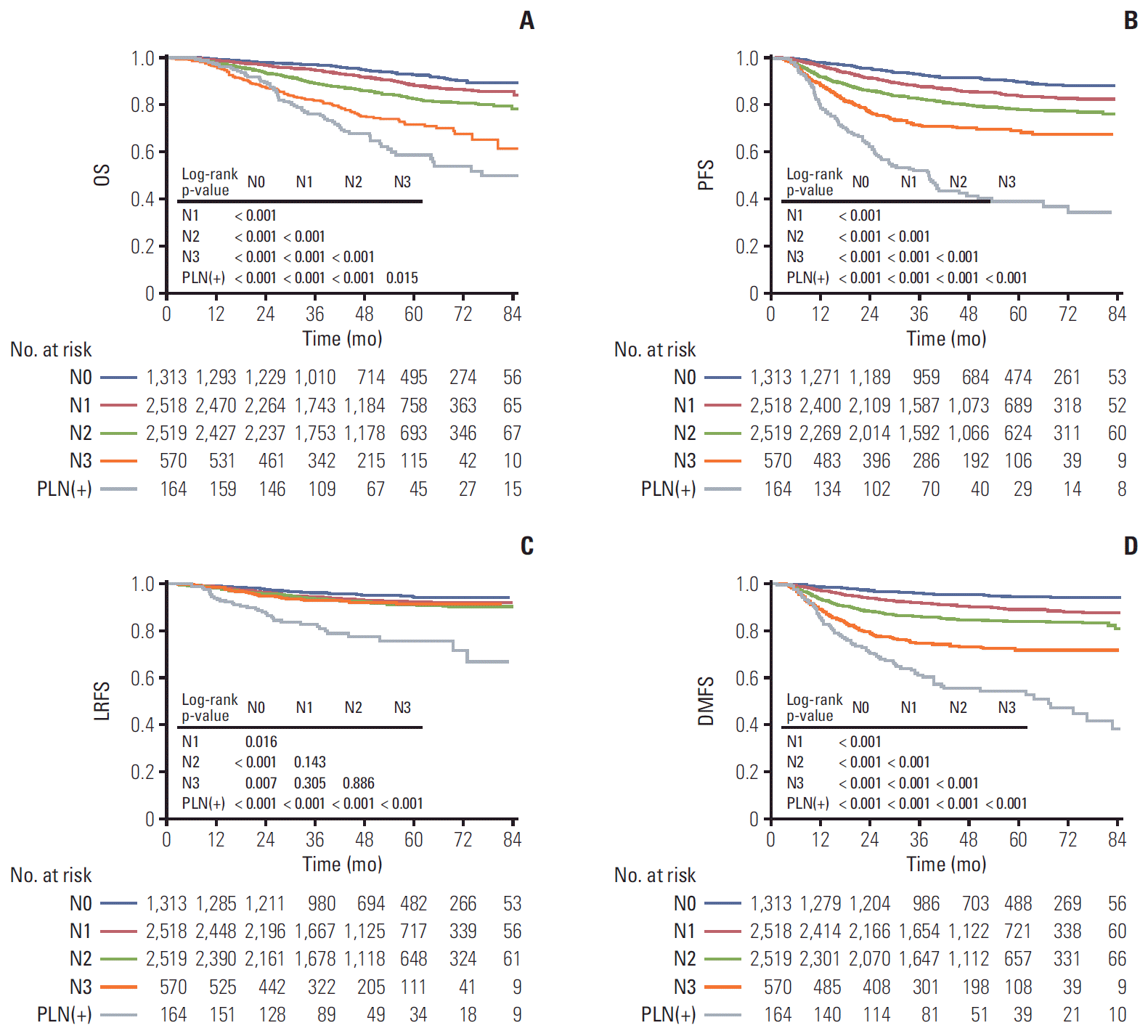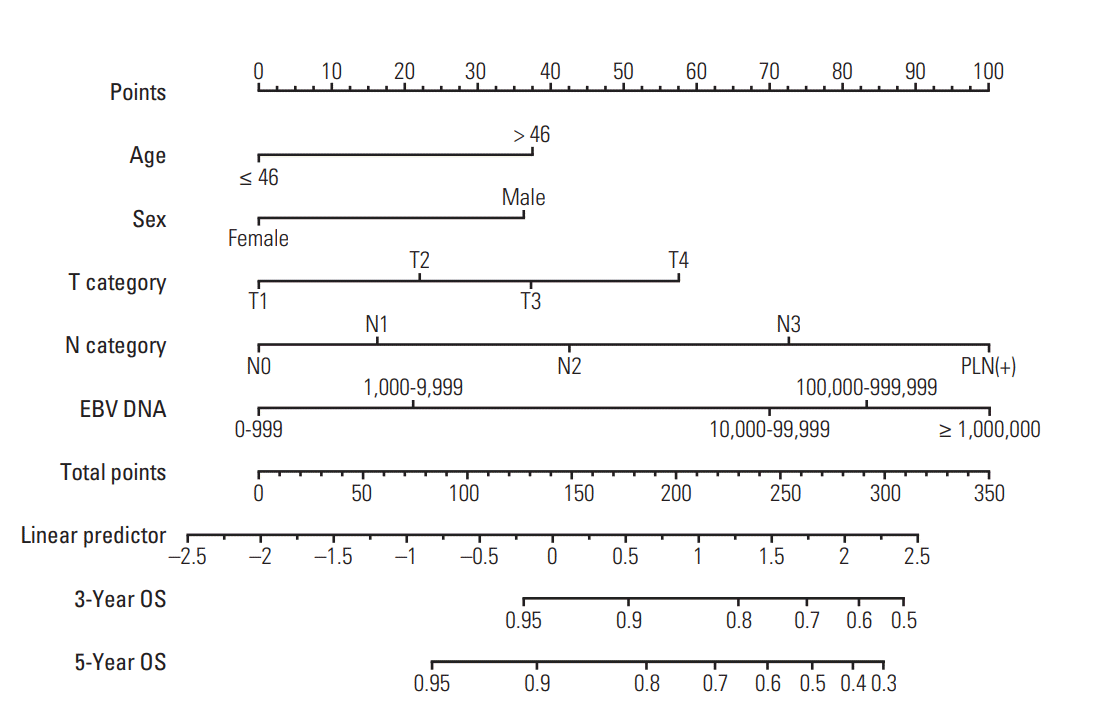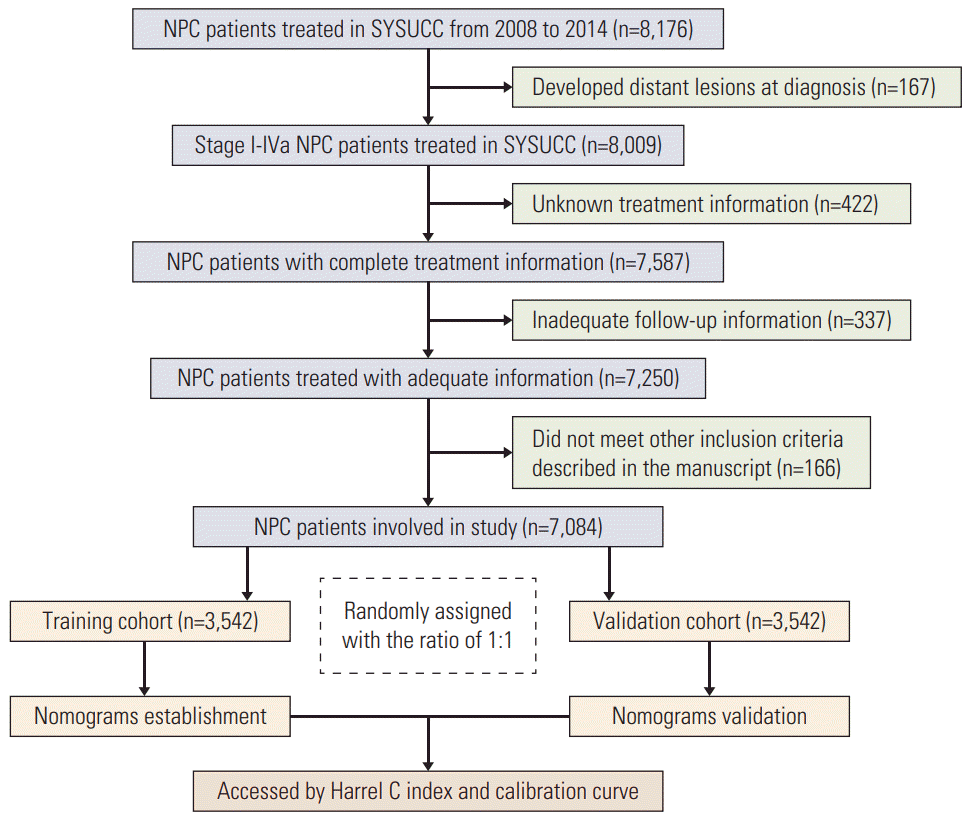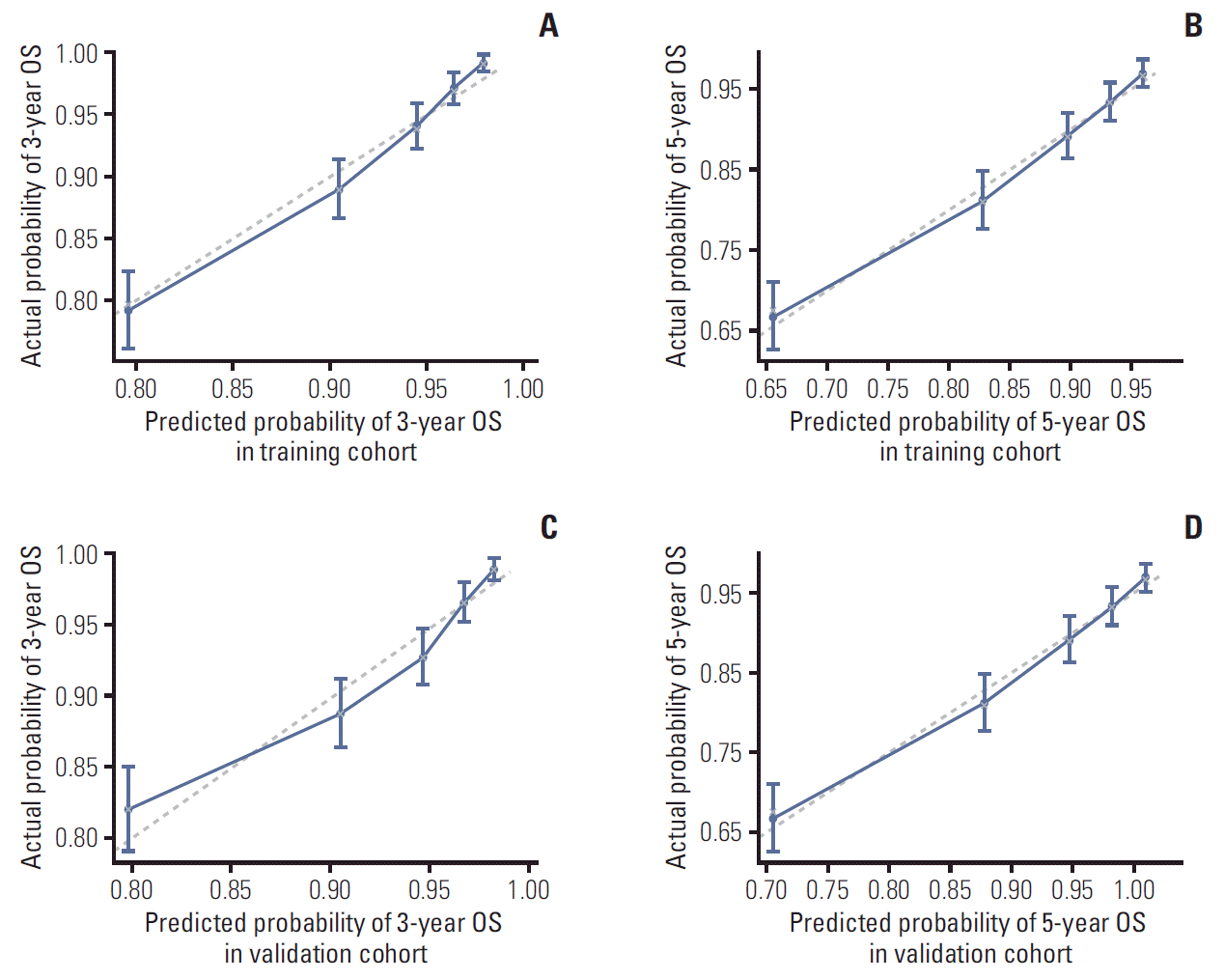Introduction
Materials and Methods
1. Patients
2. Image assessment and diagnostic criteria
3. Treatment
4. Follow-up and statistical analysis
5. Ethical statement
Results
1. Clinical characteristic and survival
Table 1.
| Characteristic | Total | PLN(–) | PLN(+) | p-value |
|---|---|---|---|---|
| Total | 7,084 | 6,920 | 164 | |
| Age (yr) | ||||
| ≤ 46 | 3,555 (50.2) | 3,471 (50.2) | 84 (51.2) | 0.813 |
| > 46 | 3,529 (49.8) | 3,449 (49.8) | 80 (48.8) | |
| Sex | ||||
| Female | 1,843 (26.0) | 1,818 (26.3) | 25 (15.2) | 0.001 |
| Male | 5,241 (74.0) | 5,102 (73.7) | 139 (84.8) | |
| T categorya) | ||||
| T1 | 597 (8.4) | 591 (8.5) | 6 (3.7) | < 0.001 |
| T2 | 1,502 (21.2) | 1,476 (21.3) | 26 (15.9) | |
| T3 | 3,390 (47.9) | 3,316 (47.9) | 74 (45.1) | |
| T4 | 1,595 (22.5) | 1,537 (22.2) | 58 (35.4) | |
| N categorya) | ||||
| N0 | 1,315 (18.6) | 1,313 (19.0) | 2 (1.2) | < 0.001 |
| N1 | 2,535 (35.8) | 2,518 (36.4) | 17 (10.4) | |
| N2 | 2,601 (36.7) | 2,519 (36.4) | 82 (50.0) | |
| N3 | 633 (8.9) | 570 (8.2) | 63 (38.4) | |
| EBV DNA level (copy/mL) | ||||
| < 1,000 | 2,800 (40.2) | 2,776 (40.1) | 24 (14.6) | < 0.001 |
| 1,000-9,999 | 1,865 (26.1) | 1,821 (26.3) | 44 (26.8) | |
| 10,000-99,999 | 1,471 (21.0) | 1,404 (20.3) | 67 (40.9) | |
| 100,000-999,999 | 743 (9.9) | 721 (10.4) | 22 (13.4) | |
| ≥ 1,000,000 | 205 (2.8) | 198 (2.9) | 7 (4.3) | |
| MAD of level II. LN (mm) | ||||
| Median (range) | 13 (3-61) | 12 (3-61) | 18 (7-41) | < 0.001 |
| Level II. LN necrosis | 1,671 (23.6) | 1,581 (22.8) | 90 (54.9) | < 0.001 |
| ECS of LN | 1,992 (28.1) | 1,850 (26.7) | 142 (86.6) | < 0.001 |
| Rare neck involvementb) | 816 (11.5) | 741 (10.7) | 75 (45.7) | < 0.001 |
| Treatment group | ||||
| RT alone | 1,238 (17.5) | 1,233 (17.8) | 5 (3.0) | < 0.001 |
| CCRT | 2,438 (34.4) | 2,403 (34.7) | 35 (21.3) | |
| IC+RT | 1,459 (20.6) | 1,439 (20.8) | 20 (12.2) | |
| IC+CCRT | 1,745 (24.6) | 1,659 (24.0) | 86 (52.4) | |
| Others | 204 (2.9) | 186 (2.7) | 18 (11.0) |
Values are presented as number (%). Rare neck areas containing level Ia/b, level Vc, and level VI involvement. p-value was calculated using Pearson chi-square test or T test. PLN, parotid lymph node; EBV, Epstein-Barr virus; MAD, minimal axial diameter; LN, lymph node; ECS, extracapsular spread; RT, radiotherapy; CCRT, concurrent chemoradiotherapy; IC, induction chemotherapy.
2. Comparison of staging categories for PLN metastasis
 | Fig. 2.Kaplan-Meier survival curves of overall survival (OS) (A), progression-free survival (PFS) (B), locoregional relapsefree survival (LRFS) (C), and distant metastasis-free survival (DMFS) (D) for comparing 164 patients with parotid lymph nodes (PLN) involvement and 6,920 patients without PLN involvement classified by N classification. |
3. The establishment nomogram model for OS involving PLN metastasis
Table 2.
| Characteristic | Training cohort (n=3,542) | Validation cohort (n=3,542) | p-value |
|---|---|---|---|
| Age (yr) | |||
| ≤ 46 | 1,801 (50.8) | 1,754 (49.5) | 0.274 |
| > 46 | 1,741 (49.2) | 1,788 (50.5) | |
| Sex | |||
| Female | 914 (25.8) | 929 (26.2) | 0.705 |
| Male | 2,628 (74.2) | 2,613 (73.8) | |
| T categorya) | |||
| T1 | 296 (8.4) | 301 (8.5) | 0.759 |
| T2 | 769 (21.7) | 733 (20.7) | |
| T3 | 1,689 (47.7) | 1,701 (48.0) | |
| T4 | 788 (22.2) | 807 (22.8) | |
| N categorya) | |||
| N0 | 666 (18.8) | 647 (18.3) | 0.959 |
| N1 | 1,258 (35.5) | 1,260 (35.6) | |
| N2 | 1,247 (35.2) | 1,272 (35.9) | |
| N3 | 289 (8.2) | 281 (7.9) | |
| PLN(+) | 82 (2.3) | 82 (2.3) | |
| EBV DNA level (copy/mL) | |||
| < 1,000 | 1,409 (39.8) | 1,391 (39.3) | 0.129 |
| 1,000-9,999 | 952 (26.9) | 913 (25.8) | |
| 10,000-99,999 | 728 (20.6) | 743 (21.0) | |
| 100,000-999,999 | 368 (10.4) | 375 (10.6) | |
| ≥ 1,000,000 | 85 (2.4) | 120 (3.4) | |
| Treatment group | |||
| RT alone | 619 (17.5) | 619 (17.5) | 0.707 |
| CCRT | 1,223 (34.5) | 1,215 (34.3) | |
| IC+RT | 741 (20.9) | 718 (20.3) | |
| IC+CCRT | 851 (24.0) | 894 (25.2) | |
| Others | 108 (3.0) | 96 (2.7) |
 | Fig. 3.Prognostic nomogram for 3- and 5-year overall survival (OS) based on the training cohort. EBV DNA, Epstein-Barr virus DNA. As an example, locate the patient's sex and draw a line straight up to the “Points” axis to determine the associated score. Add the scores achieved for each covariate, and locate this sum on the “Total Points” axis. Draw a line straight down to determine the likelihood of 3- or 5-year OS. As a calculation parameter, “Linear Predictor” is not directly applied to the calculation of the survival rate. |
Table 3.
A Cox proportional hazard model was used to conduct multivariate analyses. All variables were transformed into categorical variables. HRs were calculated for age (> 46 years vs. ≤ 46 years), sex (male vs. female), T category, N category, and EBV DNA level. OS, overall survival; PFS, progression-free survival; LRFS, locoregional relapse-free survival; DMFS, distant metastasis-free survival; HR, hazard ratio; CI, confidence interval; EBV, Epstein-Barr virus; PLN, parotid lymph node.




 PDF
PDF Citation
Citation Print
Print




 XML Download
XML Download